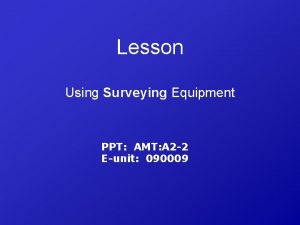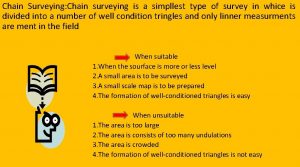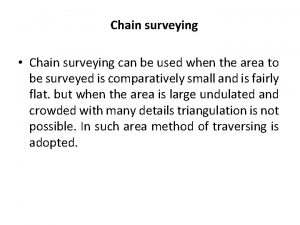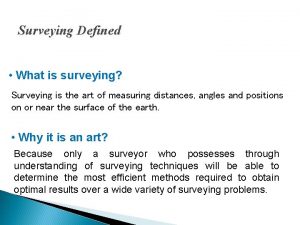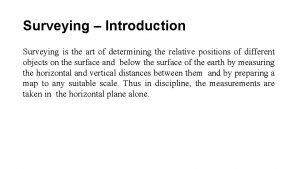CHAIN SURVEYING SURVEYING It is the art of




























- Slides: 28

CHAIN SURVEYING

SURVEYING It is the art of making such measurements as will determine the relative positions of points on the surface of the earth in order that the shape and extent of any portion may be ascertained or delineated on a map or a plan. • It is essentially the process of determining the positions of points in a horizontal plane. •

Levelling § Levelling is the art of determining and representing the relative heights or elevations of different points on the surface of the earth. § It is the process of determining the positions of points in a vertical plane.

Object of surveying The primary object of surveying is the preparation of map or plan. The results of surveying when plotted and drawn on paper constitute a plan.

Primary divisions of surveying § Plane surveying: Curvature of earth is not taken into account § Geodetic surveying (Trignometrical surveying): Curvature of earth is taken into account.

Principles of surveying Two fundamental principles: § To work from whole to part § To fix the positions of new stations at least by two independent processes.

MEASUREMENT OF DISTANCE § Direct method: distances are actually measured on the ground with chain or tape or other instruments. § Computative: Distances are obtained by calculations as in tachometry , triangulation etc. §

Direct Methods: § § § § § Pacing Passometer Pedometer Odometer Speedometer Perambulator Judging distance Time measurement. Chaining

Metric Chain § A surveying chain is a device used to measure distance between two points on the ground. § • Metric chains are available in lengths of 5 m, 10 m, 20 m and 30 m.

Metric Chain § • 20 m – 30 m chain is normally used for the field of surveying. § • A surveying chain contains brass handles with brass eyebolt and collar, galvanized mild steel links and wire rings. § • In the case of 20 m and 30 m chains, brass tallies are provided at every 5 m length and indicating brass wire rings are attached at every metre length except where tallies are provided.

Metric Chain § The distance between the outside faces of handles of a fully stretched out chain is the length of the chain. § • The length of the chain, like 20 m is engraved on the handles. § • While measuring the long distance, the chain will have to be used a number of times. § • Arrows are driven at the end of every chain length.

Metric Chain § For holding the arrows in position, grooves are cut in the outside face of the handles. § • The radius of the groove is the same as that the arrows. § • For convenient handling of the chain, the handle joint is made flexible so that it is possible to swivel to handle round the eye bolt.

Chain Pins/Arrows: § Chain pins or arrows are used with the chain for marking each chain length on the ground. § The arrow is driven into the ground at the end of each chain length is measured. § Chain pins the arrow should be made of good quality hardened and tempered steel wire of minimum tensile strength of 70 kg/mm 2. § The overall length is 400 mm and thickness is 4 mm. § The wire should be black enamelled. § The arrow has a circular eye at the one end is pointed at the other end

Chain Pins/Arrows:

Pegs: § Wooden pegs of 15 cm length and 3 cm square in section are used to establish the station points or the end points of a line on the ground. § They are tapered one end are driven into the ground by using a wooden hammer. § About 4 cm is left projecting above the ground.

Pegs:

Measuring Tape: § There are different types of tapes are used. They are § § (a) Cloth or linen type (b) Metallic Tape (c) Steel Tape (d) Invar Tube. § Metallic tape and steel tapes are most commonly used. § • Metallic Tape is made of varnished waterproof linen. § • It is reinforced with fine brass copper or bronze wires.

Measuring Tape: § Tapes are available in lengths of 10, 15, 20, 30 or 50 metres. § In metallic tapes every metre is divided into 100 divisions (cms). § In steel tapes, the centimetre division are also subdivided.

Ranging Rod: § It is also known as ranging pole or picket. § • Ranging rod is used for ranging or aligning long lines on the ground in field surveying. § • Ranging is a straight line means fixing a series of pegs or other marks such that they all lie on a straight line. § Ranging rods are used marking points on the ground so that the positions of the points are distinctly visible from some distant way. § • The length of ranging rod may be 2 m and 3 m and its diameter is 30 mm.

Ranging Rod: § • Ranging rod made of steel tube has an internal diameter of 32 mm. § • The ranging rods are made of well seasoned, straight grained timber of circular cross section. § Ranging rods should be straight and free from warps. § • The deviation in straightness should not exceed 5 mm in a 2 m length. § • The ranging rod is painted in red and white in alternate band lengths of 200 mm each. § • The bottom end of the rod is fitted with a pointed, hollow, cast iron shoe or steel shoe of 15 cm length.

Ranging Rod: § •

Offset Rod: § • It is a ranging rod with two short, narrow, vertical sighting slots passing through the centre of the section. § • A hook is fitted of a groove is cut at the top to enable pulling or pushing of the chain through obstruction like hedges. § • Offset rods are meant for setting outlines approximately at right angles to the main line.

Offset Rod:

Cross Staff: § It is used to set out right angles in chain surveying § • It consists of four metal arms vertical slits mounted on a pole. § • Two opposite slits are positioned along the length of a line (Main Line) § • A line perpendicular to the main line is formed or sighted through the other two slits

Cross Staff:

Plumb Bob: § It consists of a solid conical piece and a string attached to it at its centre. § • When in use, the solid piece is at the bottom. § • It is used to test the verticality of the ranging rods and to transfer the points to the ground. § • Plumb bob is used while doing chain surveying on sloping ground.

Plumb Bob:

Unfolding and folding of chain: § Both the handles of the chain are held in the left hand the other portions in the right hand. § The portion held in the right hand is thrown forward; § The person throwing moving backward himself. § The leader takes one handle of the chain and moves forward till the chain is stretched to its full length. § The chain should be free from any kinks or bends. § After the completion of the work, the two handles are brought together and the chain is folded started with the middle pair. § The links are placed obliquely across each pair. § The folded chain is securely tied with a rope
 Food chain sequence
Food chain sequence Total station ppt
Total station ppt Value chain and supply chain difference
Value chain and supply chain difference Closed kinetic chain definition
Closed kinetic chain definition Hát kết hợp bộ gõ cơ thể
Hát kết hợp bộ gõ cơ thể Bổ thể
Bổ thể Tỉ lệ cơ thể trẻ em
Tỉ lệ cơ thể trẻ em Gấu đi như thế nào
Gấu đi như thế nào Thang điểm glasgow
Thang điểm glasgow Alleluia hat len nguoi oi
Alleluia hat len nguoi oi Môn thể thao bắt đầu bằng chữ f
Môn thể thao bắt đầu bằng chữ f Thế nào là hệ số cao nhất
Thế nào là hệ số cao nhất Các châu lục và đại dương trên thế giới
Các châu lục và đại dương trên thế giới Cong thức tính động năng
Cong thức tính động năng Trời xanh đây là của chúng ta thể thơ
Trời xanh đây là của chúng ta thể thơ Mật thư tọa độ 5x5
Mật thư tọa độ 5x5 Làm thế nào để 102-1=99
Làm thế nào để 102-1=99 độ dài liên kết
độ dài liên kết Các châu lục và đại dương trên thế giới
Các châu lục và đại dương trên thế giới Thơ thất ngôn tứ tuyệt đường luật
Thơ thất ngôn tứ tuyệt đường luật Quá trình desamine hóa có thể tạo ra
Quá trình desamine hóa có thể tạo ra Một số thể thơ truyền thống
Một số thể thơ truyền thống Cái miệng nó xinh thế chỉ nói điều hay thôi
Cái miệng nó xinh thế chỉ nói điều hay thôi Vẽ hình chiếu vuông góc của vật thể sau
Vẽ hình chiếu vuông góc của vật thể sau Thế nào là sự mỏi cơ
Thế nào là sự mỏi cơ đặc điểm cơ thể của người tối cổ
đặc điểm cơ thể của người tối cổ Thế nào là giọng cùng tên
Thế nào là giọng cùng tên Vẽ hình chiếu đứng bằng cạnh của vật thể
Vẽ hình chiếu đứng bằng cạnh của vật thể

